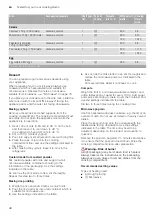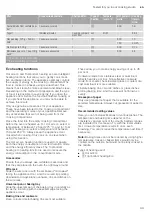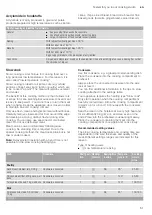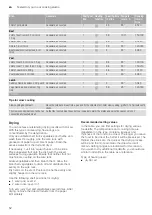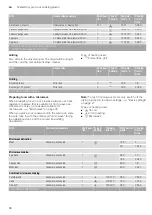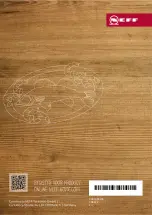
Tested for you in our cooking studio
en
49
Eco heating functions
Hot air eco and Top/bottom heating eco are intelligent
heating functions that allow you to gently cook meat,
fish and baked items. The appliance optimally controls
the supply of energy to the cooking compartment.The
food is cooked in phases using residual heat. This
means that it remains more succulent and browns less.
Depending on the method of preparation and the type
of food, it is possible to save energy. If you open the
appliance door before the food has finished cooking or
if you preheat the appliance, you may not be able to
achieve this result.
Only use genuine accessories for your appliance.
These have been tailored to the cooking compartment
and the operating modes of your appliance.Remove
any accessories that are not being used from the
cooking compartment.
Place the food into the empty cooking compartment
before the oven is heated up. For Hot air eco, select a
temperature of between 125 and 275 °C, and for Top/
bottom heating eco, select a temperature of between
150 and 250 °C. Always keep the appliance door
closed when cooking. Only cook on one level when
using this function.
The Hot air eco heating function is used to measure
both the energy consumption in air recirculation mode
and the energy efficiency class. The Top/bottom
heating eco heating function is used to measure the
energy consumption in the conventional mode.
Accessories
Ensure that you always use suitable accessories and
that they are placed in the oven the right way around.
Wire rack
Slide the wire rack in with the embossed "microwave"
facing the appliance door, and the curved lip pointing
downwards. Always place ovenware, tins and dishes on
the wire rack.
Universal pan or baking tray
Slide the universal pan or the baking tray in carefully as
far as the limit stop with the bevelled edge facing the
appliance door.
Baking tins and cookware
Dark- coloured metal baking tins are most suitable.
These allow you to make energy savings of up to 35
per cent.
Cookware made from stainless steel or aluminium
reflects heat like a mirror. Non-reflective cookware
made from enamel, heat-resistant glass or coated, die-
cast aluminium is more suitable.
Tinplate baking tins, ceramic dishes or glass dishes
prolong baking time, and the cake will not brown so
evenly.
Greaseproof paper
Only use greaseproof paper that is suitable for the
selected temperature. Always cut greaseproof paper to
size.
Recommended setting values
Here, you can find specifications for various dishes. The
temperature and baking time depend on the
consistency and amount of the dough. Settings ranges
are indicated for this reason. Try with the lower values
first. A lower temperature results in more even
browning. You can increase the temperature next time if
necessary.
Note:
Baking times can not be reduced by using higher
temperatures. Cakes or baked items would only be
cooked on the outside, but would not be fully cooked in
the middle.
Types of heating used:
■
ž
Hot air Eco
■
‘
Top/bottom heating Eco
Dish
Accessories/cookware
Shelf position
Type of
heating
Tempera-
ture in °C
MW power in
watts
Cooking
time in
mins.
Custard made from custard pow-
der*
Cookware, covered
1
•
-
600
5-8
Yogurt
Individual moulds
Cooking compart-
ment floor
Œ
40-45
-
8-9h
Rice pudding, 125 g + 500 ml
milk*
Cookware, covered
1
•
-
600
10
180
20-25
Fruit compote, 500 g
Cookware, covered
1
•
-
600
9-12
Microwave popcorn, 1 bag 100 g
each**
Cookware, uncovered
1
•
-
600
4-6
* Stir once or twice while cooking
** Place sealed bag on cookware














